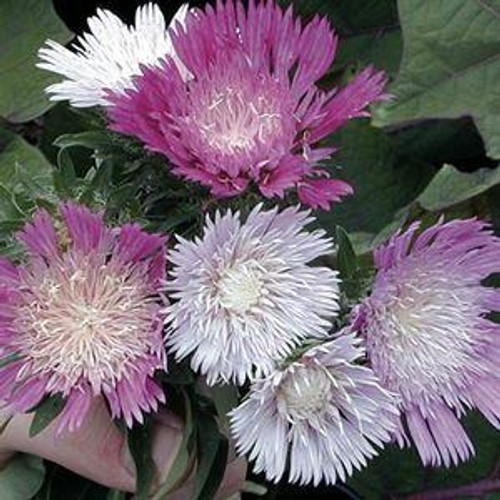Product Description
Stokesia laevis 'Color Wheel' PP12718 (10)ct Quarts
Common Name: Stokes' Aster.
Type: Herbaceous perennial
Family: Asteraceae
Zone: 5 to 9
Height: 1.50 to 2.00 feet
Spread: 1.00 to 1.50 feet
Bloom Time: June to September
Bloom Description: White aging to lavender and purple
Sun: Full sun
Water: Medium
Maintenance: Low
Rabbit and Drought resistant
Stokesia laevis 'Color Wheel' is a captivating variety of Stokes' aster that lives up to its name by displaying a mesmerizing array of colors on a single plant.
It is a fantastic addition to gardens, offering a long bloom season and attracting pollinators with its showy flowers.
- Flowers: The unique feature of 'Color Wheel' is its multi-colored flowers. The blooms open pure white and then gradually change color as they mature, transitioning through shades of lavender and eventually to deep purple. This creates a beautiful color wheel effect on the plant, with flowers of different colors blooming simultaneously.
- Foliage: The lance-shaped, leathery, green leaves form a basal rosette. They provide an attractive backdrop for the colorful flowers and add to the plant's overall appeal.
- Growth Habit: It forms a clump that typically grows 1.5 to 2 feet tall and 1 to 1.5 feet wide.
- Hardiness: It is hardy in USDA zones 5-9, making it suitable for a wide range of climates.
- Long Bloom Time: It blooms from late spring to fall, providing an extended period of color in the garden.
Growing Conditions:
- Sunlight: It prefers full sun but can tolerate some light shade, especially in hotter climates.
- Soil: It thrives in well-drained soil and can tolerate poor, dry soil once established.
- Moisture: It prefers consistent moisture but is relatively drought-tolerant once established.
Uses in the Landscape:
- Borders: Its multi-colored flowers and neat foliage make it a standout addition to perennial borders.
- Cottage Gardens: It blends well with other cottage garden plants, adding a touch of wildflower charm.
- Pollinator Gardens: The large, showy flowers attract butterflies and other pollinators.
- Cut Flowers: The long-lasting blooms are excellent for cut flower arrangements.
Additional Tips:
- Deadheading: Deadheading spent flowers can encourage additional blooms and prevent self-seeding.
- Division: It can be divided every few years in spring to maintain plant vigor and propagate new plants.
- Deer and Rabbit Resistance: It is generally deer and rabbit resistant.
Overall, Stokesia laevis 'Color Wheel' is a captivating and low-maintenance perennial that adds a unique touch to the garden with its multi-colored flowers. Its long bloom season, adaptability, and attractiveness to pollinators make it a popular choice for gardeners seeking a vibrant and easy-care plant.
Ten (10) plants in quart containers per flat (or tray).
Other Details
The most important part of the plant is its root system. Healthy roots are the foundation of a healthy, vibrant plant. The type of plug container used is based on the specific needs of the plants. Perennials offered as bare root traditionally perform better when planted as bare root.Planted in a specialized mix, potted plants have well established root systems. Top growth stage will vary depending on the current life cycle and time of year when shipped. In Winter and early Spring dormant plants may be shipped. Dormant plants may be planted right away, even before the last frost date.
Most bare root varieties are field grown for at least one season, though Hemerocallis and Hosta are grown for two seasons. The bulk of the soil is removed during the harvesting process and the tops of most varieties are trimmed back to the crown. They are graded, packed in shredded aspen or sphagnum moss and stored in freezers until ready to be shipped.
See our Container Sizes and Bare Root Perennials pages for more information.
Plant information and care is provided in the Overview section, Plant Genus Page and general information is provided in the Planting Care & Guides. Additional questions can be asked on each Plant page.
Plant Spacing: Using the maximum mature spread or width of a plant to guide spacing, ensures space to grow to full size. To fill an area sooner, plant them closer together. Just remember, future thinning or transplanting may be needed.
Water: Keep a close eye on newly planted perennials, especially throughout the first growing year. Most early plant loss is due to too much or too little water!






